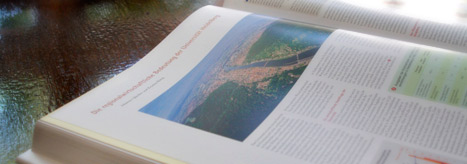Wissenschaftsatlas of Heidelberg University

When universities celebrate their major anniversaries, the medium they most commonly employ to document their state of the art in research and teaching is surely the commemorative volume. Such jubilees afford an opportunity to tell a university’s story and to interpret its development in a manner that serves to justify the festive occasion. Germany’s oldest university dispensed with the time-honoured mode of imparting university history and opted instead to present itself in an atlas
.
The concept and maps of the Wissenschaftsatlas emphasise the view that research and learning processes do not take place in a social, political, or economic vacuum; they are influenced by a multitude of spatial relations and factors whose local interaction results in a spatial context or a milieu. The success of research projects or the intellectual development and academic careers of young scholars are thus contingent not only on the goals, talents, and creativity of the people involved, but also on existing local structures and spatial relations. Each university location affords a scientist a different knowledge environment, which, in turn, has a bearing on whether and how soon new scientific concepts, practices, or technical innovations are accepted and acted upon or how that scientist is able to develop. The aim of this atlas is to ascertain such dynamics, visualise them with maps and diagrams, explain them with texts and depict the university’s historical high and low points as well as its inspiring diversity and excellence intelligibly to a broad audience. The work portrays both the development since 1386 and the current situation of Heidelberg University. It shows that Heidelberg University has always been not just a local player but one firmly established in Europe, and the globalised world of science.
The uncommonly diverse illustrative approaches used in the atlas are bound to pique the interest of its readers and invite them to expand their current knowledge about Heidelberg University or to discover some of its previously unknown aspects. It is particularly important that the atlas helps make Heidelberg University’s research questions, structural issues, and historical developments clear and understandable to a wide public.
The professionally designed and lavishly illustrated Wissenschaftsatlas of Heidelberg University was published first in a German (2011) and now (2012) in a slightly extended English edition. It was made possible only through the outstanding financial and logistical assistance by companies and individuals and the concentrated efforts by the members of the Heidelberg Institute of Geography, the Leibniz Institute for Regional Geography in Leipzig, and some 135 authors reflecting the university’s academic breadth. The atlas project was conceived and directed by Peter Meusburger, and its exceptional cartographic execution was ensured by the Leibniz Institute for Regional Geography in Leipzig.
Meusburger, Peter & Schuch, Thomas (Ed.) (2012): Wissenschaftsatlas of Heidelberg University. Spatio-temporal relations of academic knowledge production. Knittlingen: Bibliotheca Palatina. ISBN 978-3-9811463-4-9


